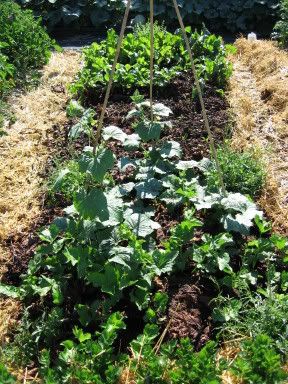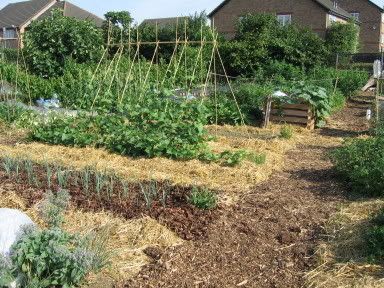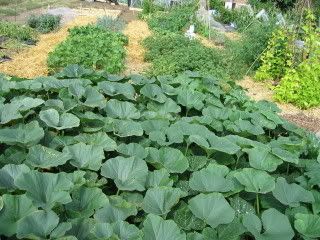I have merged together three of Supersprout's posts for everyone to read and enjoy.
Measure out with string, mulch what you're not going to plant with black plastic - then you start to tread on the paths and not the beds, and can adjust lengths and widths of beds and paths as you learn what suits you best. Don't even think about permanent edging til you have the layout that works best for you.
Make sure you can reach easily to the middle of the beds - I reduced mine from 1.25m wide to 1.1m wide - and that the paths are wide enough to accommodate you/plant overhangs/wheelbarrow (I started with 60cm wide).
Grow for a season at least, preferably two or three, and adjust, adjust, adjust.
No need to dig - mulch, plant through black plastic, and when you harvest you will aerate the soil and mix in the mulch.
I don't edge my beds - no need, no expense, and I don't have a slug problem unlike my neighbours who have wooden bed edges.
If you're interested, some pics of my non-edged bed system - heavily mulched for summer!



Happy gardening, and make sure you have plenty of string
If you're physically constrained, you could run a no-dig plot with heavy mulch so very little weeding too - that's what I've come around to, and it works for me

for aerating the soil every year, I use a broadfork - which makes light work of the job:

18 months ago, just after I'd taken on two new allotments I became unable to bend, stretch or pull! So I had to find a way of growing without hoeing, digging or weeding.
We marked out beds and paths with string; scythed down top growth and left it on the ground mulched with compost, manure, spent hops and leaves; covered beds with black plastic; and planted through holes in the plastic. I had to make some planting holes with a crowbar and seek manly help to put beanpoles and stakes into the ground, it was so hard
I made semi-permanent paths with thickly laid newspaper topped with straw and/or woodchips, so it's obvious where to tread or not and I can move the wheelbarrow round the allotment easily between the beds.
The black plastic and exhausted perennial roots came out with the first harvest, and from then on I have mulched thickly with whatever organic matter I can find. After two seasons, the ground has softened, annual weeds don't take, and the occasional perennial weed is easy to pull out - roots and all - if they make it through the mulch.
Clearing crops included squash, brassicas, leeks, French beans, potatoes, and Jerusalem Artichokes, and we got excellent crops from all of them.
The soil here is silt turning to clay. The plot used to be marshy in parts, but doesn't waterlog now; the beds have lifted slightly over the 18 months of adding organic matter, and we never tread on the soil. When you lift up the mulch it's seething with worms!
'Extreme mulching' comes from Ruth Stout's writing (worth a Google). A thick layer of organic mulch (<8 inches) will suppress weeds - it really is as simple as that. I use straw because it's easy and cheap to get hold of from farms, and rots down well - other people use leaves, lawn mowings, raw or cooked compost, manure, spent hops, paper shreddings and so on.
Might be something in it for you? This is the plot:
No-dig: summer

No-dig: winter

I wish I'd come across this way of cultivating years ago - it's sheer luxury to spend the time mulching, sowing, planting, tending and harvesting instead of digging, weeding and hoeing. Disability has been a blessing in disguise for me and I hope something good comes out of it for you and your plot too
Measure out with string, mulch what you're not going to plant with black plastic - then you start to tread on the paths and not the beds, and can adjust lengths and widths of beds and paths as you learn what suits you best. Don't even think about permanent edging til you have the layout that works best for you.
Make sure you can reach easily to the middle of the beds - I reduced mine from 1.25m wide to 1.1m wide - and that the paths are wide enough to accommodate you/plant overhangs/wheelbarrow (I started with 60cm wide).
Grow for a season at least, preferably two or three, and adjust, adjust, adjust.
No need to dig - mulch, plant through black plastic, and when you harvest you will aerate the soil and mix in the mulch.
I don't edge my beds - no need, no expense, and I don't have a slug problem unlike my neighbours who have wooden bed edges.
If you're interested, some pics of my non-edged bed system - heavily mulched for summer!



Happy gardening, and make sure you have plenty of string

If you're physically constrained, you could run a no-dig plot with heavy mulch so very little weeding too - that's what I've come around to, and it works for me


for aerating the soil every year, I use a broadfork - which makes light work of the job:

18 months ago, just after I'd taken on two new allotments I became unable to bend, stretch or pull! So I had to find a way of growing without hoeing, digging or weeding.
We marked out beds and paths with string; scythed down top growth and left it on the ground mulched with compost, manure, spent hops and leaves; covered beds with black plastic; and planted through holes in the plastic. I had to make some planting holes with a crowbar and seek manly help to put beanpoles and stakes into the ground, it was so hard

I made semi-permanent paths with thickly laid newspaper topped with straw and/or woodchips, so it's obvious where to tread or not and I can move the wheelbarrow round the allotment easily between the beds.
The black plastic and exhausted perennial roots came out with the first harvest, and from then on I have mulched thickly with whatever organic matter I can find. After two seasons, the ground has softened, annual weeds don't take, and the occasional perennial weed is easy to pull out - roots and all - if they make it through the mulch.
Clearing crops included squash, brassicas, leeks, French beans, potatoes, and Jerusalem Artichokes, and we got excellent crops from all of them.
The soil here is silt turning to clay. The plot used to be marshy in parts, but doesn't waterlog now; the beds have lifted slightly over the 18 months of adding organic matter, and we never tread on the soil. When you lift up the mulch it's seething with worms!
'Extreme mulching' comes from Ruth Stout's writing (worth a Google). A thick layer of organic mulch (<8 inches) will suppress weeds - it really is as simple as that. I use straw because it's easy and cheap to get hold of from farms, and rots down well - other people use leaves, lawn mowings, raw or cooked compost, manure, spent hops, paper shreddings and so on.
Might be something in it for you? This is the plot:
No-dig: summer

No-dig: winter

I wish I'd come across this way of cultivating years ago - it's sheer luxury to spend the time mulching, sowing, planting, tending and harvesting instead of digging, weeding and hoeing. Disability has been a blessing in disguise for me and I hope something good comes out of it for you and your plot too



